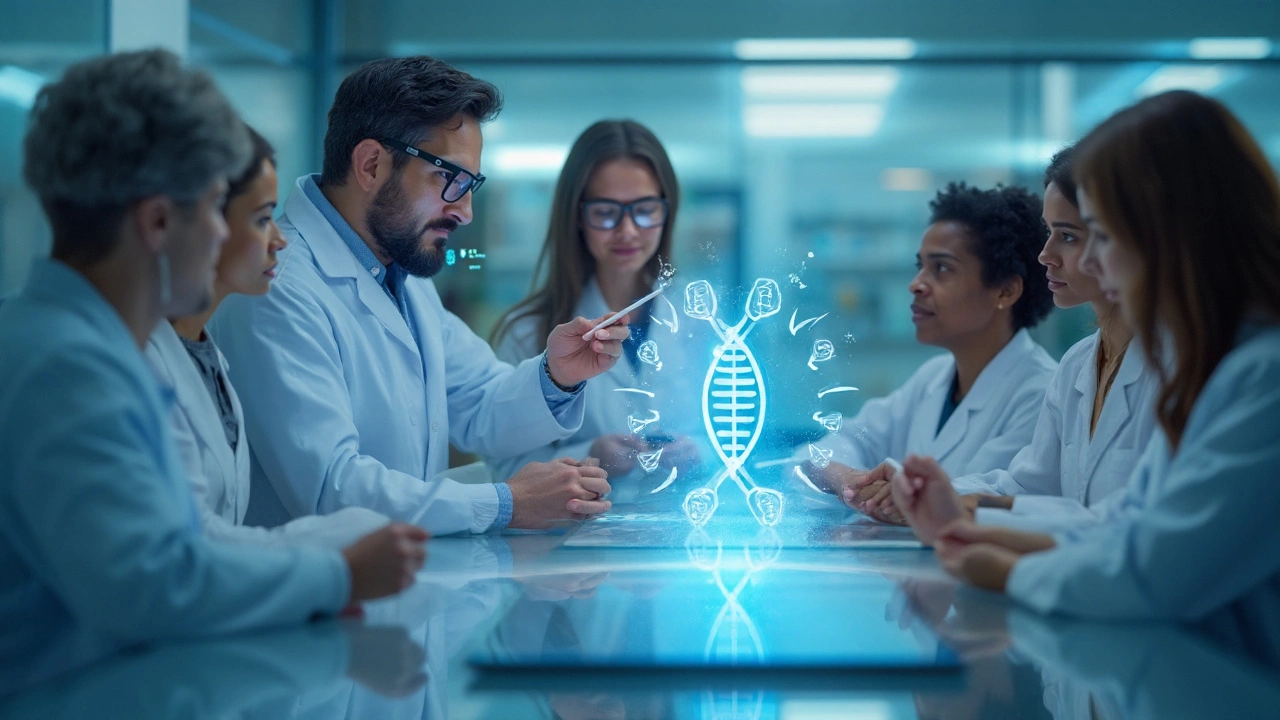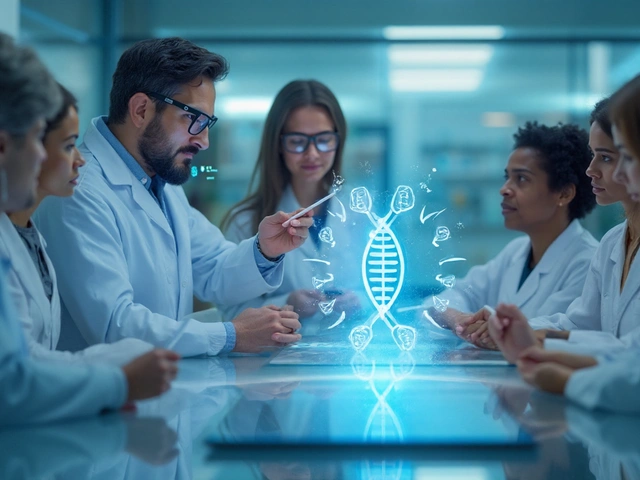Bone marrow donation is a medical procedure where healthy stem cells are harvested from the pelvic bones of a donor and infused into a recipient to re‑establish blood‑forming capability. In the context of chronic lymphocytic leukemia (CLL), this donation can be the cornerstone of a curative‑intent therapy called a hematopoietic stem cell transplant.
Patients diagnosed with CLL often face a slow‑growing cancer that clings to the bone‑marrow environment, evading standard chemotherapy. When the disease becomes refractory, oncologists turn to transplant options that replace the faulty marrow with fresh, disease‑free stem cells. Understanding how bone marrow donation fits into this therapeutic puzzle is crucial for patients, families, and potential donors.
What Is Chronic Lymphocytic Leukemia?
Chronic lymphocytic leukemia is a type of blood cancer that originates from mature B‑lymphocytes. These malignant cells accumulate in the bone marrow, blood, and lymphoid tissues, crowding out normal blood cells. According to the World Health Organization, CLL accounts for about 25% of leukemias in Western countries, with a median age at diagnosis of 70 years.
The disease follows an indolent course in many patients, but a subset experiences rapid progression, severe infections, or transformation into aggressive lymphoma (Richter’s transformation). When conventional therapies no longer control the disease, a stem‑cell transplant becomes a viable option.
How Hematopoietic Stem Cell Transplant Works
Hematopoietic stem cell transplant (HSCT) is a procedure that replaces a patient’s diseased marrow with healthy stem cells from a donor (allogeneic) or from the patient themselves (autologous). The process involves three steps: high‑dose conditioning (chemotherapy and/or radiation), infusion of stem cells, and post‑transplant immune recovery.
In CLL, the allogeneic approach is preferred because it introduces a graft‑versus‑leukemia (GVL) effect-donor immune cells recognize and attack residual leukemia cells. The source of those donor cells can be bone marrow, peripheral blood stem cells (PBSC), or umbilical cord blood, each with distinct pros and cons.
Why Bone Marrow Donation Matters for CLL
Bone marrow remains the gold‑standard source for many CLL transplants for several reasons:
- Higher CD34+ cell dose - The concentration of stem cells capable of re‑population is often greater in marrow harvests, leading to robust engraftment.
- Lower risk of chronic graft‑versus‑host disease (cGVHD) compared with PBSC, which is critical for older CLL patients who have limited tolerance for long‑term immunosuppression.
- Provides a broader immunologic repertoire, enhancing the GVL effect that can eradicate hidden leukemia clones.
Clinical trials from the European Group for Blood and Marrow Transplantation (EBMT) reported a 5‑year overall survival of 55% for CLL patients receiving bone‑marrow‑derived allogeneic HSCT, compared with 48% for PBSC recipients. While numbers vary by age and disease status, the data consistently highlight bone marrow’s role in improving long‑term outcomes.
Comparing Stem‑Cell Sources
| Attribute | Bone Marrow | Peripheral Blood Stem Cells | Umbilical Cord Blood |
|---|---|---|---|
| Collection method | Surgical harvest under anesthesia | Leukapheresis (outpatient) | Banked cord after birth |
| Typical CD34+ dose (×10⁶/kg) | 3-5 | 5-10 | 0.5-2 |
| Engraftment speed (days) | 15-21 | 10-14 | 21-35 |
| Donor recovery | 3-5 days of mild pain | Usually none | Not applicable |
| cGVHD incidence | 15-20% | 30-40% | 10-15% |
| Preferred for CLL? | Yes - lower cGVHD & stronger GVL | Often used when rapid engraftment needed | Limited by cell dose |

Donor Eligibility and HLA Matching
Donor eligibility criteria include age 18‑55, weight >50kg, no major health issues, and a negative infectious disease screen. Potential donors must also meet specific laboratory values: hemoglobin ≥12g/dL for women, ≥13g/dL for men, platelet count ≥150×10⁹/L, and normal cardiac function.
The success of any allogeneic HSCT hinges on human leukocyte antigen (HLA) compatibility. HLA matching examines key loci (A, B, C, DRB1, DQB1). An 8/8 or 10/10 match reduces the risk of graft‑versus‑host disease and improves survival. For CLL patients, registries such as the National Marrow Donor Program (NMDP) maintain databases of over 30million volunteers, making it increasingly likely to find a suitable match.
The Transplant Procedure and Recovery
Once a donor is cleared, the transplant timeline usually follows this pattern:
- Conditioning regimen - High‑dose fludarabine combined with cyclophosphamide or reduced‑intensity total body irradiation prepares the recipient’s marrow.
- Stem‑cell infusion - The bone‑marrow product is delivered intravenously over 15‑30minutes, similar to a blood transfusion.
- Engraftment monitoring - Daily blood counts track neutrophil recovery (usually by day 14) and platelet recovery (by day 21).
- Immune reconstitution - Prophylactic antibiotics, antivirals, and antifungals protect against infection while the new immune system rebuilds.
- Long‑term follow‑up - Quarterly assessments for the first two years, then semi‑annual checks, focus on disease status, chronic GVHD, and organ function.
Donors experience a short hospital stay, pain control with NSAIDs, and full activity resumption within a week. Recipients, especially older CLL patients, require extensive supportive care, but many report renewed energy levels once engraftment stabilizes.
Outcomes, Survival Rates, and Risks
Multiple retrospective analyses (e.g., Mayo Clinic 2022 cohort of 412 CLL transplant recipients) show a 3‑year disease‑free survival of 48% for allogeneic HSCT, with bone‑marrow donors edging out PBSC donors by roughly 6% in disease‑free intervals. However, the procedure carries notable risks:
- Acute GVHD (grades II‑IV) in 20-30% of cases.
- Infections - bacterial, viral (CMV reactivation), fungal, especially in the first 100 days.
- Organ toxicity from conditioning (hepatic veno‑occlusive disease, renal impairment).
- Secondary malignancies - rare but reported after long‑term immunosuppression.
Proactive donor screening, optimal HLA matching, and reduced‑intensity conditioning have lowered early mortality to under 15% in modern series. For patients with high‑risk cytogenetics (e.g., del(17p)), transplant offers the only potential cure, making the risk‑benefit calculus favorable.
Related Concepts and Next Steps
Understanding bone‑marrow donation in CLL connects to broader topics such as:
- Graft‑versus‑Leukemia immunotherapy - harnessing donor T‑cells to target residual disease.
- CAR‑T cell therapy - an emerging, non‑transplant cellular treatment for relapsed CLL.
- Minimal residual disease (MRD) monitoring - using flow cytometry to gauge transplant success.
- Patient‑reported outcomes - quality‑of‑life metrics after transplant.
Readers interested in deeper dives might explore articles on reduced‑intensity conditioning protocols, strategies to prevent chronic GVHD, or the role of donor lymphocyte infusion (DLI) in sustaining remission.

Frequently Asked Questions
Can anyone become a bone‑marrow donor for CLL?
Potential donors must meet health criteria (age 18‑55, adequate weight, no infectious diseases) and pass a rigorous HLA match test. While not everyone qualifies, registries have millions of volunteers, increasing the odds of finding a compatible match for most patients.
Why is bone‑marrow donation preferred over peripheral blood for CLL?
Bone‑marrow grafts tend to produce lower rates of chronic graft‑versus‑host disease, which is crucial for older CLL patients. They also deliver a diverse immune cell population that strengthens the graft‑versus‑leukemia effect, potentially improving long‑term remission.
What is the typical recovery time for a bone‑marrow donor?
Donors usually stay overnight, experience mild pelvic discomfort for 3‑5 days, and return to normal activities within a week. Full recovery of marrow cellularity occurs in 4‑6 weeks.
How successful are bone‑marrow transplants in curing CLL?
Cure rates vary by disease stage and donor match. Recent studies report a 5‑year overall survival of around 55% for well‑matched bone‑marrow transplants, with many patients achieving durable remission and a quality‑of‑life comparable to healthy peers.
What are the major risks for the recipient after a bone‑marrow transplant?
Key risks include acute and chronic graft‑versus‑host disease, infections during immune reconstitution, organ toxicity from conditioning, and, rarely, secondary cancers. Close monitoring and prophylactic measures have reduced early mortality to below 15% in modern protocols.



Bone marrow transplants are just a way for the elite to control our health.
Reading through this deep dive on bone‑marrow transplants gave me a huge boost of hope! The way you broke down the GVL effect made the science feel almost cinematic. For anyone scared about donor recovery, remember that most donors are back on their feet within a week – that’s incredible. Keep spreading the word; every extra volunteer could be the difference between life and death for a CLL patient. Your post is a shining beacon for the community.
The data you cited from EBMT pretty much validates the supremacy of marrow over PBSC – higher CD34+ dose, lower cGVHD, stronger GVL. Honestly, if you’re still debating, you’re just buying into the pharma‑driven hype. This is real science, not some fluffy talk. Get on board or get left behind.
Wow, this is a masterclass in transplant immunology! 😲 The breakdown of conditioning regimens and engraftment timelines is spot‑on. I love how you highlighted the donor’s quick recovery – it really demystifies the process. 👍 Keep the detailed explanations coming!
While the article is exhaustive, it still glosses over the socioeconomic barriers that prevent many patients from accessing matched donors. The glossed‑over mention of HLA matching costs betrays a naive optimism. One must consider the underlying healthcare inequities that skew survival statistics. Moreover, the reliance on European trial data may not translate globally. A more critical lens is warranted.
Look, the whole marrow vs PBSC thing is just another academic debate that doesn’t change the fact most people don’t get a match at all. The article is solid but kinda overkill for the average reader.
Bone marrow donation, especially for chronic lymphocytic leukemia, represents a profound act of altruism that transcends medical jargon. When we consider the graft‑versus‑leukemia effect, we see how donor immune cells can hunt residual cancer cells with a precision that chemotherapy simply cannot match. This immunologic advantage becomes even more critical in patients with high‑risk cytogenetics such as del(17p). The lower incidence of chronic GVHD associated with marrow grafts preserves quality of life, allowing older patients to maintain independence. Moreover, the higher CD34+ cell dose ensures robust engraftment, reducing the window of severe immunosuppression. Donors experience only mild pelvic discomfort for a few days, and full activity resumes within a week, which I find remarkably low for such a life‑saving procedure. Recipients, on the other hand, undergo a rigorous conditioning regimen that, while intense, clears the marrow niche for the new stem cells. Post‑transplant monitoring is meticulous, with daily counts guiding neutrophil and platelet recovery milestones. The inclusion of prophylactic antimicrobials further shields patients from opportunistic infections during immune reconstitution. Data from the Mayo Clinic 2022 cohort underscores a 3‑year disease‑free survival near 48%, illustrating real‑world efficacy. It is also worth noting that ongoing trials are exploring reduced‑intensity conditioning to further lower toxicity. For families navigating CLL, understanding these nuances can empower informed decision‑making. The psychological impact of knowing a donor is willing to undergo an invasive procedure cannot be overstated. In many cases, the hope generated by a potential cure outweighs the temporary discomfort of donation. Ultimately, bone marrow donation stands as a cornerstone in the multidisciplinary management of CLL, offering a realistic pathway toward durable remission.
Sounds like donors get a quick recovery.
Oh great, another reason to make more people get poked in the hip 😏
The transplant journey reads like an epic saga, each phase a battle against invisible foes. From conditioning storms to the hopeful dawn of engraftment, the emotional rollercoaster is palpable. I can feel the patient’s anxiety and the donor’s quiet bravery echoing through each line. This piece captures that intensity beautifully.
Thank you for laying out the recovery timeline so clearly; it really helps families plan ahead.
Great article! I just wanted to point out that “engraftment” is often misspelled as “engraftement” – keep an eye on that. Also, consider using “recipient” consistently instead of alternating with “patient.” Overall, very informative.
This guide does a fantastic job of demystifying donor eligibility. For anyone unsure about the weight requirements, remember it’s more about overall health than a strict number. Keep sharing such valuable resources!
If we think of bone marrow as the seed of our very being, then transplantation becomes a rebirth of the self. The donor offers not just cells, but a fragment of their existence, weaving a new narrative for the recipient. It’s a reminder that life is a tapestry of shared threads. In this light, CLL is not just a disease but a catalyst for profound connection.
Honestly, the article sounds like a PR piece for the transplant industry. It glosses over the fact that many centers push transplants to boost revenue, ignoring long‑term complications. Readers deserve a harsher truth about the financial incentives at play.
While the clinical data appears robust, one must consider the potential influence of pharmaceutical sponsorship on study outcomes. Independent verification of these survival rates is essential to ensure transparency. Without such scrutiny, the presented benefits may be overstated.
Clear info no fluff
The immunologic nuance of graft‑versus‑leukemia underscores a paradigm where donor T‑cell repertoire becomes a living pharmacologic vector. Such cellular symbiosis challenges conventional monotherapy doctrines and invites a systems‑biology perspective. Embracing this complexity could herald next‑gen therapeutic frameworks.
The manuscript offers a comprehensive overview of transplant protocols; however, the occasional misspelling-such as “condtioning” instead of “conditioning”-detracts from its professionalism.
Because who doesn’t love a good bone‑marrow harvest?